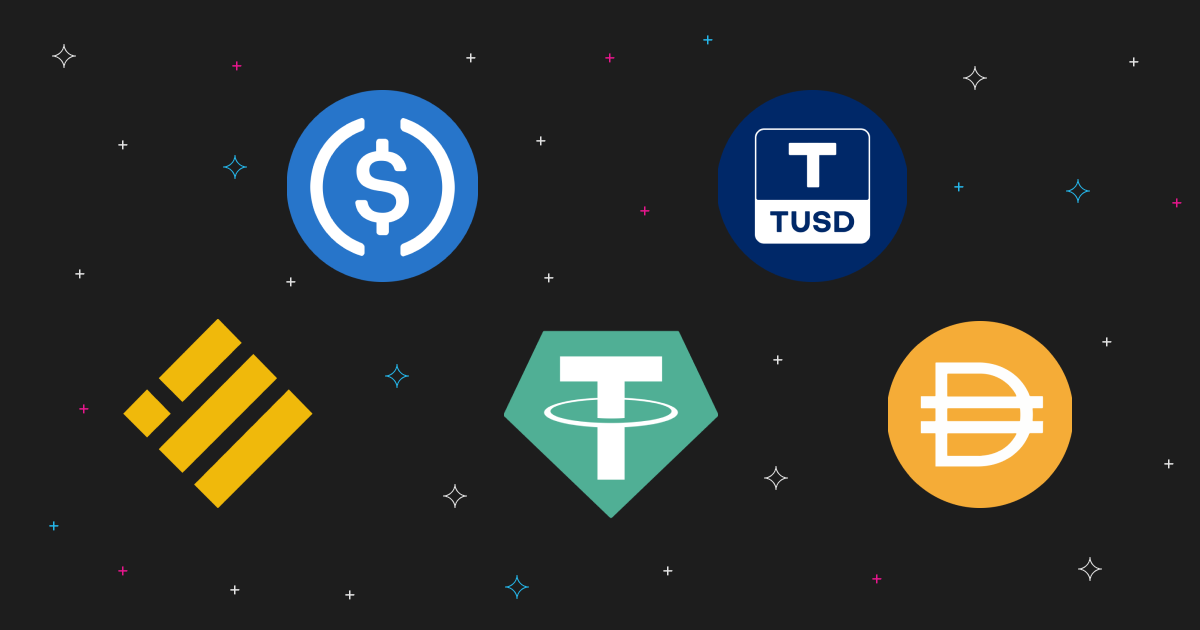Bitcoin and other cryptos have several benefits to offer investors and traders, and users and that include making transactions openly with no trust issues or the need for a third-party intermediary. However, the wild volatility of these cryptocurrencies can be the most obstructing roadblock for users.
This is where stablecoins come in. Stablecoins have cemented their status as a vital part of the crypto ecosystem. That is due in part to the volatile nature of speculative cryptos like LTC, BNB, BTC, ETH, etc. Even though stablecoin is also a cryptocurrency, its asset is fixed to the value of other asset classes like fiat or gold for price stability.
So what is a stablecoin? How do stablecoins work? Are stablecoins safe? We will now give all these answers to you and of course, here you’ll also find a list of stablecoins to choose from.

What are stablecoins?
The purpose of stablecoins is to offer price stability. This group of cryptocurrencies is often supported with a reserve asset. Over the years, stablecoins have developed to be the most prominent and important class of cryptocurrencies.
Stablecoins provide instant processing and privacy of payments with cryptocurrencies. They also offer stable or volatility-free valuations of fiat currencies. The very essence of stablecoins is to stabilize the volatility of cryptocurrency prices by pairing them with a fiat currency or other more stable assets.
Organizations operating stablecoins always set up reserves to store assets backing the stablecoin. For instance, $1 million of the real asset can be used to back up a million units of stablecoin.
In other words, these stablecoins are fixed to real-world assets, which are reserved to serve as collateral for the stablecoin. A stablecoin transaction that involves a stablecoin holder withdrawing his asset results in an equal amount of the asset taken from the reserve.

How do stablecoins work?
Apart from being able to stabilize price volatility, stablecoins are also supported by multiple sources of assets. It could be a traditional currency like the US dollar, commodity, precious metals, or algorithmic functions, or other cryptocurrencies. However, the risk level for stablecoins is greatly influenced by its backing.
- Fiat-Backed Stablecoins
For fiat-backed stablecoins, you can use your fiat currency to trade for a stablecoin paired to that fiat currency and retrieve it later for your initial real-time deposit.
Fiat stablecoins are the most stable of all stablecoins when it comes to price volatility, little to no changes are seen in its price.

- Crypto-Backed Stablecoins
These stablecoins are supported by other cryptocurrencies. Since crypto-assets (High Price Volatility) are used to back these stablecoins, they are over-insured to maintain the price value.
- Precious Metal-Backed Stablecoins
Precious metals like gold are used to maintain the price value of these stablecoins.
- Algorithmic Stablecoins
Unlike other stablecoins, algorithmic stablecoins aren’t backed by any asset. The algorithmic stablecoins operations have proven to be the hardest to understand. Algorithmic stablecoins price values are kept in check using a computer algorithm.

List of the best stablecoins
Here is a list of stablecoins that are very popular in the market.
Tether (USDT)
Tether is one of the leading organizations in stablecoin market. Tether (USDT) blockchain cryptocurrency is backed by an amount of U.S dollars equivalent to the tokens in circulation. Its stable crypto coins are always at $1.00.
Tether tokens were designed by the BitFinex crypto exchange platform. In addition, Tether (USDT) is a native token of the Tether network. As of November 9, 2021, USDT is ranked as the sixth-biggest cryptocurrency according to market capitalization, with a worth of $73,331,418,457. Tether is considered one of the safest assets and if you adhere to this point of view and keep a bunch of bitcoins in your pocket, check out how to exchange BTC to USDT instantly at the best rate.

Binance USD (BUSD)
Another top organization in the stablecoin utility is Binance. Binance (BUSD) can be described as a 1:1 USD-backed stable digital fiat currency issued by Binance and Paxos.
BUSD has also been approved and regulated by the New York State Department of Financial Services (NYDFS). Furthermore, users can access and view the BUSD Monthly Audit Report via the Binance Official Website.
The launch of BUSD was on the fifth of September 2019 and it was aimed at bringing the stability of the dollar onto blockchain technology. BUSD was initially issued as an ERC-20 token, but now it has expanded into Binance BEP-20 and BEP-2 ecosystems.

Dai (DAI)
MakerDAO runs the operations of DAI stable crypto coins. MakerDAO is its decentralized governance community, with a primary function of maintaining DAI’s price stability. As we all know, the DAI stablecoin is connected to the value of the U.S dollar.
Thanks to the collateralized debt denominated in Ether (ETH), DAI stablecoin is also able to keep its value in check. The Collateralized Debt Positions are the smart contracts on the Maker protocol used to ensure price stability. CDPs give users the access to securely lock their collateral assets while generating DAI.

True USD (TUSD)
Developed on the Trust Token platform, True USD (TUSD) is the first of its kind to be built on this platform. TUSD is not only a collateralized ERC-20 verified token but also a legally protected stable cryptocurrency.
The reserve of TUSD real-time U.S dollars are deposited in different bank accounts under the name of Trust Companies. With the agreement to publish and conduct monthly audits on the collateralized reserve, users can be assured of stability and transparency.
Multiple escrow accounts have also been opened to reduce counterparty risk, thus providing TUSD holders protection against larceny.

USD Coin (USDC)
The USD Coin (USDC) has been designed to provide similar functions like Tether and True USD; it was only launched in recent years. USDC first came into light on September 26, 2018, when Circle partnered with Coinbase.
In summary, USD Coin tokenizes US dollars for blockchain uses. Just like other stable cryptocurrencies, USDC can be converted back into real USD. ERC-20 smart contract ensures the implementation of issuing and redeeming USDC tokens.

How to buy stablecoin or exchange Bitcoin to stable cryptocurrency?
Now that you’re willing to secure your crypto profits from the bull run, you can easily convert them with Swapzone. Just follow our detailed guide here below:
- Launch Swapzone on your internet browser.
- Locate the “select pair” tab.
- In the “send” section select BTC and in the “get up to” section, select any stablecoin.
- Enter all the correct details in the tabs. You will now be able to see all the different exchange rates offered on Swapzone.
- Choose the offer that best suits you and then click on “exchange”.
- Enter your wallet details and make sure that they are correct. Once you’ve verified everything is correct, click on “proceed to exchange”.
- This will prompt the transaction to start. At this point, all you have to do is wait for the transaction to complete.
- Once the transaction is done, take a moment to rate the exchange partner and leave a review. The process is done.

FAQ about stablecoins
Are stablecoins safe?
Stable crypto coins are considered the safer options in the market because the price is mostly stable so there’s little to no risk in holding them. However, the little risk to stable cryptocurrencies can be worrying sometimes.
You have to know that even though the price of a stable won’t fall, it won’t increase either. This means there’s no reward for holding it, which is also why its risk level is low. Furthermore, the asset paired with a stablecoin sometimes determines the risk level of the stablecoin.
There’s still a possibility for an increase or decrease to happen based on whatever happens to the asset paired with it. For instance, a stable coin paired with a dollar is dependent on the value of the U.S dollar in real-time.
Lastly, it is important to know if the organization in control of the stable cryptocurrency possesses the collateral it claims to have. Central authorities without adequate collateral reserves won’t be able to meet their financial obligations. One thing is most of the centralized bodies holding these reserves are not transparent about them.
![]()
Where can I buy stablecoin?
You can get stablecoins on well-known exchanges like Easybit, SimpleSwap, or on exchange aggregators like Swapzone. Almost all types of stablecoins are supported by these exchanges.
There is also the option of getting them on decentralized exchanges where you can swap your asset for stablecoins.
Is Bitcoin a stablecoin?
No, Bitcoin is not a stablecoin. Bitcoin belongs to the more volatile class of cryptocurrencies.
Is XRP a stablecoin?
No, XRP is not a stablecoin. XRP is also a more volatile type of cryptocurrency.
Which stablecoin is the best?
Most of the top stable coins in circulation have proven that they are here to stay and their increasing popularity is the evidence. So, what is the best stablecoin to use? Well, each stablecoin has its strength and area of utilities where they are most useful and desirable. However, if we are to go by popularity and acceptance level, Tether (USDT) will take the crown of which stablecoin is the best to use in the crypto market.

Which stablecoin to use?
Last year saw stablecoins take center stage in the crypto world, and their supply grew to as large as $28 billion from $5 billion at the start of 2020. As of November 1, 2021, the total stablecoin supply has surged past $135 Billion. So, the question now is which stablecoin to use? The answer is dependent on your preferences as well as what you want to use the stablecoin for.
For many users, USDT is their go-to stablecoin, given that it is present on so many chains including Ethereum, Tron, Binance Smart Chain, Solana, etc.
However, if you are going to be operating in a specific ecosystem that has its own issued stablecoin then it is best to use that stablecoin. For example, the Binance ecosystem has its own issued stablecoin called BUSD although Tether is also available there.
The same goes for Coinbase with USDC as its own issued stablecoin. So, your choice about which stablecoin to use is dependent on where and how you want to use it.



